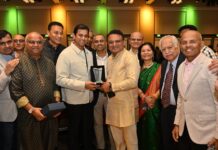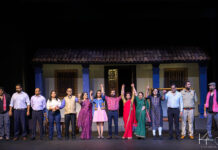
Javed, Shabana interviewed in Chicago
CHICAGO IL: Famed actress Shabana Azmi and her husband, scriptwriter, Javed Akhtar, feel that Indian cinema thematically lacked the depth of 50s and 60s and avoided social issues.
This observation was part of a wide range of questions at the Drury Lane Theater at Oak Brook Terrace on Saturday, June 8 – the first public event of the six week Eye on India Festival (EIF) 2013 being held in Chicago.
They were introduced and interviewed by EIF host Sanjoy Roy, Director of Teamwork Productions. Questions, also from the floor, revolved around Hindi cinema, its social role and alleged degeneration, Muslim identity and the place of Urdu, and their experience as nominated members of Rajya Sabha.
What do 100 years of Indian cinema represent for you?
Javed: With all its variety, technical sophistication, Indian cinema has never been so young. However, the depth of the 50s and 60s is somewhat missing and real social issues are being avoided. The middle class has become insular and has apparently sidestepped. The average protagonist used to be from the working class. And now the hero of the new make-believe world is a rich man living in a palatial mansion and steps outside onto a street in Switzerland.
What made you stick with independent cinema since Ankur (1974)?
Shabana: Both my parents believed art should be an instrument of social change. We were eight communist families living in a commune, who believed in social equity, gender equality and Indian pluralism. My aesthetics has been framed by exposure to the best of Western cinema at Pune Film School. Shyam Benegal offered me the lead heroine role in Ankur (1974), and I’ve continued to receive such offers since. I made a conscious decision not to work in films that degrade women or make them subservient to men. This has stuck with me since.
Javed: Amar Akbar Anthony reflects a yearning for a secular dispensation. Bollywood can’t avoid social issues even if the director does not consciously address them. The villain has evolved from (feudal) zamindar to capitalist to underworld boss, with the latter eventually usurping the hero’s role due to widespread disillusionment with society and its institutions. The “angry young man” takes the law into his own hands. But now we are even devoid of villains [laughter].
What to make of writers who now make amalgams from DVDs?
Javed: Mere “stealing” of scenes and scripts from other movies will not ensure success. Shailendra’s “phir bhi dil hai Hindustani” still holds true. This attitude and practice properly reflects our society, which is already influenced by the West. But the underlying moral and aesthetic sense – the thoughts expressed – have to remain Indian if audiences are not to reject them.
Is the impoverishment of movie song lyrics due to populism?
Javed: Indian society is becoming divided economically, also between multiplexes (tickets at over 100 Rupees) and single theaters (10 Rupees). Middle classes, who used to be familiar with literature, culture, etc., are learning English at the cost of their indigenous languages; their vocabulary is shrinking. Percussion is louder than voice because musicians are brought up in Western pop. But predominance of song and dance goes back to the 3500 year-old tradition in Sanskrit and vernaculars. Mainstream cinema needs to raise the lowest common denominator.
What is your forecast for next few decades?
Shabana: Women will break out of their stereotyped image, once exemplified by silent suffering roles played Meena Kumari, for parallel cinema has started giving them more substantive roles. Their choice in mainstream cinema had been limited to the extremes of chaste Madonna versus westernized whore. Flawed women characters in their flesh-and-blood complexity are now already coming to the fore, but working women are only just becoming visible. Mythology has remained dominant in both cinema and real life with Rama and Sita upheld as models.
Javed: The ideal of the suffering virtuous doormat housewife has frayed apart. But no one wants or dares to define the (image of the) contemporary Indian woman. The latter have begun to assert themselves in Hindi cinema by making outrageous statements that sound ridiculous, e.g., the idle cognac-drinker in search of her inner woman. The scene is wholly confused.
What has become of the social responsibility of films?
Shabana: Documentaries, less viewed, focus more on such issues. But Aamir Khan’s Taare Zameen Par did more for dyslexia than all activists put together. The social impasse is leading to the menace of revolution.
Javed: What is the secret of (my) scripting a super hit film like Sholay? Bimal Roy did not make Sujata out of some extraneous agenda of social responsibility, nor did Raj Kapoor Shree 420. It was simply the innate social consciousness of the director being expressed naturally.
Shabana: Combating rape and homophobia is the responsibility not only of film industry but of the entire citizenry. Industry did do some soul searching after the recent Delhi incident. Young men and women forced the government’s hand within a month. Instead of the victim being blamed, the new slogan by women is “shift the shame, shift the blame.”
How has depiction of minorities changed in Hindi cinema?
Javed: No film was made on trauma of Partition until 13 years later. Mainstream cinema developed the alternative, or good, Muslim: poet, nawab, nawab’s daughter, and courtesan. The token good Muslim used to save heroine for Hindu hero and not for himself. But films have emerged where the Muslim identity is subsidiary to the character as a whole. Actors like Dilip Kumar, who got his break in 1944, shedding their inherited Muslim names is a thing of the past, as evidenced by the contemporary Khans. Even Hollywood actors have changed their names, e.g., John Wayne. There is not much significance in this.
What is the future of Urdu in Hindi films (in dialogue, song, etc.)?
Javed: The misnomer of “Hindi” cinema was there right from the beginning in the 30s, perhaps due to stigma attached to this medium in Muslim society. There have been some attempts to reclaim them as “Urdu” but it is already too late. Their language now is actually neither Urdu nor Hindi, but rather Hindustani, a mixture that leans more towards Urdu. I’ve met Pakistanis who persist in calling them Urdu films. Syntax is the same with about 15% vocabulary imposed from either side. Language was Hindustani but leaning towards Urdu because of the poetic heritage, etc.
The afternoon began with Zeshan Begawadi, singing several Urdu poems by Kafi Azmi, Shabana’s father.
Asian Media USA





